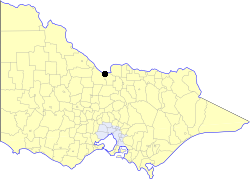City of Echuca
 From Wikipedia - Reading time: 5 min
From Wikipedia - Reading time: 5 min
| City of Echuca Victoria | |||||||||||||||
|---|---|---|---|---|---|---|---|---|---|---|---|---|---|---|---|
 Location in Victoria | |||||||||||||||
| Population | 9,740 (1992)[1] | ||||||||||||||
| • Density | 373.75/km2 (968.0/sq mi) | ||||||||||||||
| Established | 1865 | ||||||||||||||
| Area | 26.06 km2 (10.1 sq mi) | ||||||||||||||
| Council seat | Echuca | ||||||||||||||
| Region | North Central Victoria | ||||||||||||||
| County | Gunbower, Rodney | ||||||||||||||
 | |||||||||||||||
| |||||||||||||||
The City of Echuca was a local government area in Victoria, Australia, about 200 kilometres (124 mi) north of Melbourne, the state capital. Based around the regional centre of Echuca, along the Murray River, the city covered an area of 26.06 square kilometres (10.1 sq mi), and existed from 1865 until 1994.
History
[edit]The Borough of Echuca was incorporated on 3 January 1865, and became a city on 1 March 1965, just after its centenary celebrations.
On 18 November 1994, the City of Echuca was abolished, and along with the Town of Kyabram, the Shires of Deakin, Rochester and Waranga, and some neighbouring districts, was merged into the newly created Shire of Campaspe.[2]
Wards
[edit]The City of Echuca was not divided into wards, and its nine councillors represented all electors in the city.
Population
[edit]| Year | Population |
|---|---|
| 1954 | 5,405 |
| 1958 | 6,130* |
| 1961 | 5,443 |
| 1966 | 7,046 |
| 1971 | 7,505 |
| 1976 | 7,873 |
| 1981 | 7,943 |
| 1986 | 8,409 |
| 1991 | 9,438 |
* Estimate in the 1958 Victorian Year Book.
References
[edit]- ^ Australian Bureau of Statistics, Victoria Office (1994). Victorian Year Book. p. 52. ISSN 0067-1223.
- ^ Australian Bureau of Statistics (1 August 1995). Victorian local government amalgamations 1994-1995: Changes to the Australian Standard Geographical Classification (PDF). Commonwealth of Australia. p. 5. ISBN 0-642-23117-6. Retrieved 5 January 2008.
 KSF
KSF